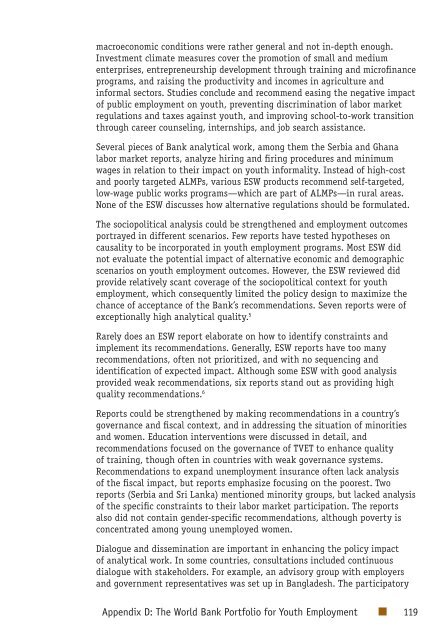Youth Employment Programs - Independent Evaluation Group
Youth Employment Programs - Independent Evaluation Group
Youth Employment Programs - Independent Evaluation Group
You also want an ePaper? Increase the reach of your titles
YUMPU automatically turns print PDFs into web optimized ePapers that Google loves.
macroeconomic conditions were rather general and not in-depth enough.Investment climate measures cover the promotion of small and mediumenterprises, entrepreneurship development through training and microfinanceprograms, and raising the productivity and incomes in agriculture andinformal sectors. Studies conclude and recommend easing the negative impactof public employment on youth, preventing discrimination of labor marketregulations and taxes against youth, and improving school-to-work transitionthrough career counseling, internships, and job search assistance.Several pieces of Bank analytical work, among them the Serbia and Ghanalabor market reports, analyze hiring and firing procedures and minimumwages in relation to their impact on youth informality. Instead of high-costand poorly targeted ALMPs, various ESW products recommend self-targeted,low-wage public works programs—which are part of ALMPs—in rural areas.None of the ESW discusses how alternative regulations should be formulated.The sociopolitical analysis could be strengthened and employment outcomesportrayed in different scenarios. Few reports have tested hypotheses oncausality to be incorporated in youth employment programs. Most ESW didnot evaluate the potential impact of alternative economic and demographicscenarios on youth employment outcomes. However, the ESW reviewed didprovide relatively scant coverage of the sociopolitical context for youthemployment, which consequently limited the policy design to maximize thechance of acceptance of the Bank’s recommendations. Seven reports were ofexceptionally high analytical quality. 5Rarely does an ESW report elaborate on how to identify constraints andimplement its recommendations. Generally, ESW reports have too manyrecommendations, often not prioritized, and with no sequencing andidentification of expected impact. Although some ESW with good analysisprovided weak recommendations, six reports stand out as providing highquality recommendations. 6Reports could be strengthened by making recommendations in a country’sgovernance and fiscal context, and in addressing the situation of minoritiesand women. Education interventions were discussed in detail, andrecommendations focused on the governance of TVET to enhance qualityof training, though often in countries with weak governance systems.Recommendations to expand unemployment insurance often lack analysisof the fiscal impact, but reports emphasize focusing on the poorest. Tworeports (Serbia and Sri Lanka) mentioned minority groups, but lacked analysisof the specific constraints to their labor market participation. The reportsalso did not contain gender-specific recommendations, although poverty isconcentrated among young unemployed women.Dialogue and dissemination are important in enhancing the policy impactof analytical work. In some countries, consultations included continuousdialogue with stakeholders. For example, an advisory group with employersand government representatives was set up in Bangladesh. The participatoryAppendix D: The World Bank Portfolio for <strong>Youth</strong> <strong>Employment</strong> 119
















